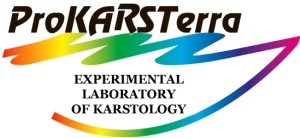
NTERNATIONAL SCIENTIFIC-PRACTICAL NETWORK ProKARSTerra
(based at NIGGG-BAS)
It was created in 2009 in connection with an international project of the ProKARSTerra Laboratory (funded by the Science Research Fund). The structure and functions of the network follows to the ProKARSTerra paradigm model. The network is based on a MSSQL "ProKARSTerra" server at NIGG-BAS and aims to integrate specialized information, methodologies and experiences and to unite and coordinate the interests and efforts of researchers, experts, managers, educators and trainees in various aspects of Karstology. The Network maintains and extends the established international collaboration and partnership of the Laboratory and facilitates the organization of a number of international forums and initiatives as well as academic exchanges, including exchange of expertise. The network is in the process of continuous development.
Partners on the network
Czech Republic- Správa jeskyní České republiky (SJ ČR), Praha
- Správà chráněné krajinné oblasti (CHKO) Moravský kras, Agentuřà ochrany přírody a krajiny ČR
- Oddělení dozimetrie záření, Ústav jaderné fyziky AV ČR, v. v. i., Praha
- Oddělení inženýrské geologie, Ústav struktury a mechaniky hornin AV ČR, v. v. i., Praha
- Oddělení environmentální geografie (Brno), Ústav geoniky AV ČR, v.v.i., Ostrava
- Uniwersytet Śląski, Wydział Nauk o Ziemi, Sosnowiec, Polska
- Zespół Parków Krajobrazowych Województwa Śląskiego, Będzin, Polska
- Yamaguchi University, Japan
- Akiyoshi-dai Quasi-National Park (Mine, Yamaguchi), Japan
- Akiyoshi-dai Museum of Natural History (Akiyoshi), Japan
- “Atelier 4” ltd. Architecture, Engineering, Hydrogeology, Geotechnics. Tirana – Albania
Note: This list does not include educational institutions with which the Laboratory collaborates on educational projects and initiatives of the ProKARSTerra-Edu strategy, incl. more than 15 schools from Bulgaria, Montenegro, Latvia, Japan, the Czech Republic, Tatarstan, Germany and others.
Specialized web sites, supported on the ProKARSTerra server in the Laboratory:
- http://www.prokarstterra.bas.bg
- http://www.prokarstterra.bas.bg/lab
- http://prokarstterra.bas.bg/forum2005
- http://prokarstterra.bas.bg/forum2012
- http://prokarstterra.bas.bg/forum2015
- http://prokarstterra.bas.bg/forum2019
- http://prokarstterra.bas.bg/competition
- http://prokarstterra.bas.bg/sci-competition
- http://prokarstterra.bas.bg/travel-school
- http://www.prokarstterra.bas.bg/geo21
SPECIALIZED MONITORING NETWORKS
- BGSpeleo-RadNet (for Monitoring of 222-Radon in Bulgarian Caves - based in the Laboratory at NIGGG-BAS)
It was built in 2011 in cooperation with the Department of Radiodosimetry of the Institute of Nuclear Physics of the Czech Republic, Prague. For radon monitoring, diffuser chambers with passive trace detectors (using a collaborative experimental methodology) are used and periodically replaced. Calibration and detector processing is carried out at the Institute of Nuclear Physics of the Czech Academy of Sciences.
At present, the network includes 45 caves (including 11 electrified show caves) with a total of 74 monitoring points. Speleo-monitoring of radon is a pilot work for Bulgaria, which is why caves representative of different types of karst and with different circulatory regime and morphology have been selected. Since 2016, instrumental monitoring (periodic, in model caves) has been carried out with AlphaE (Professional Meter for Radon concentration, Personal Exposure and Dose) of SAPHYMO GmbH.
BGSpeleo-RadNet provides objective information in three scientific-applied fields:
- The role of natural radiation processes in modern karst genesis;
- Relation between radon and earthquake activity;
- Radiation protection of the workers in karst caves.
In some of the model caves, in addition to radon monitoring, additional radiological monitoring of gamma-background (with TLD dosimeters in 8 caves) and 14Ñ activity (in 16 caves with samplers with hard NaOH sorbent) are performed.
- EU-TecNet (European Tectonic Monitoring Network) – for monitoring of slow tectonic movements along faults and caves - based at the Institute of Structure and Mechanics of the Rocks of the Czech Republic, Prague.
In Bulgaria, the Laboratory maintains monitoring in 5 caves with a total of 7 TM-71 extensometers installed: in Bacho Kiro cave – one, at Saeva dupka cave - one (since April 2012), in Bisserna cave on the Shumen Plateau - three (from December 2015), in Uhlovitsa cave – one and Lepenica cave - one (since April 2018). The installed devices are located at points of the BGSpeleo-RadNet network aiming to reveal connections between changes in the radon concentration and the seismic activity.
